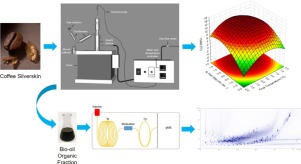当前位置:
X-MOL 学术
›
J. Anal. Appl. Pyrol.
›
论文详情
Our official English website, www.x-mol.net, welcomes your
feedback! (Note: you will need to create a separate account there.)
Valorization of coffee silverskin industrial waste by pyrolysis: from optimization of bio-oil production to chemical characterization by GC × GC/qMS
Journal of Analytical and Applied Pyrolysis ( IF 5.8 ) Pub Date : 2018-01-01 , DOI: 10.1016/j.jaap.2017.12.005 Allan dos Santos Polidoro , Enelise Scapin , Eliane Lazzari , Aline Nunes Silva , Anaí Loreiro dos Santos , Elina Bastos Caramão , Rosângela Assis Jacques
Journal of Analytical and Applied Pyrolysis ( IF 5.8 ) Pub Date : 2018-01-01 , DOI: 10.1016/j.jaap.2017.12.005 Allan dos Santos Polidoro , Enelise Scapin , Eliane Lazzari , Aline Nunes Silva , Anaí Loreiro dos Santos , Elina Bastos Caramão , Rosângela Assis Jacques

|
Abstract Coffee bean tegument (silverskin) is a by-product derived from the coffee roasting process. This residue has been discarded, which constitutes a serious environmental problem. The depletion of oil reserves and environmental issues promoted by the combustion of fossil fuels has generated interest in the use of biomass to obtain fuel and chemicals products. The liquid product obtained by biomass pyrolysis is commonly called bio-oil. Bio-oil is a complex mixture of compounds, and its detailed chemical characterization is necessary to prospect its potential uses. Therefore, this study optimized the final temperature of pyrolysis and N2 flow rate parameters for the pyrolysis of silverskin in a fixed bed reactor, by using a central composite design and response surface. The bio-oil chemical composition was evaluated by comprehensive two-dimensional gas chromatography coupled to rapid-scanning quadrupole mass spectrometry (GC × GC/qMS), combined with the use of standards and linear temperature-programmed retention indices (LTPRI). The optimal values calculated were 560 °C for the final pyrolysis temperature and 49 mL min−1 for the N2 flow rate. The organic phase yield was 15.2% under these conditions. At the optimal conditions, 228 compounds were identified (90.1% of the sample chromatographic volume) in the organic phase. The major chemical class, in terms of volume percentage, were the phenols (26.70%), followed by nitrogen compounds (18.51%). In addition, it is worth mentioning the high representability of the saturated hydrocarbons (8.28%), unsaturated aliphatic (6.69%), and aromatics (7.77%), which together account for 22.74% of the sample chromatographic volume. These results showed that the silverskin bio-oil may have the potential use as a source of chemical inputs.
中文翻译:

热解咖啡银皮工业废料的价值化:从生物油生产的优化到 GC × GC/qMS 的化学表征
摘要 咖啡豆皮(银皮)是咖啡烘焙过程中的副产品。这些残留物已被丢弃,这构成了严重的环境问题。石油储量的枯竭和化石燃料燃烧引起的环境问题引起了人们对使用生物质来获得燃料和化学品产品的兴趣。通过生物质热解获得的液体产品通常称为生物油。生物油是一种复杂的化合物混合物,其详细的化学表征对于展望其潜在用途是必要的。因此,本研究通过使用中心复合设计和响应面优化了固定床反应器中银皮热解的热解最终温度和 N2 流量参数。通过综合二维气相色谱与快速扫描四极杆质谱 (GC × GC/qMS) 结合使用标准品和线性程序升温保留指数 (LTPRI) 评估生物油的化学成分。计算的最佳值为最终热解温度为 560 °C,N2 流速为 49 mL min-1。在这些条件下有机相产率为15.2%。在最佳条件下,在有机相中鉴定了 228 种化合物(样品色谱体积的 90.1%)。就体积百分比而言,主要化学类别是酚类 (26.70%),其次是氮化合物 (18.51%)。此外,值得一提的是饱和烃 (8.28%)、不饱和脂肪族 (6.69%) 和芳烃 (7.77%) 的高代表性,共占样品色谱量的 22.74%。这些结果表明银皮生物油可能具有作为化学输入来源的潜在用途。
更新日期:2018-01-01
中文翻译:

热解咖啡银皮工业废料的价值化:从生物油生产的优化到 GC × GC/qMS 的化学表征
摘要 咖啡豆皮(银皮)是咖啡烘焙过程中的副产品。这些残留物已被丢弃,这构成了严重的环境问题。石油储量的枯竭和化石燃料燃烧引起的环境问题引起了人们对使用生物质来获得燃料和化学品产品的兴趣。通过生物质热解获得的液体产品通常称为生物油。生物油是一种复杂的化合物混合物,其详细的化学表征对于展望其潜在用途是必要的。因此,本研究通过使用中心复合设计和响应面优化了固定床反应器中银皮热解的热解最终温度和 N2 流量参数。通过综合二维气相色谱与快速扫描四极杆质谱 (GC × GC/qMS) 结合使用标准品和线性程序升温保留指数 (LTPRI) 评估生物油的化学成分。计算的最佳值为最终热解温度为 560 °C,N2 流速为 49 mL min-1。在这些条件下有机相产率为15.2%。在最佳条件下,在有机相中鉴定了 228 种化合物(样品色谱体积的 90.1%)。就体积百分比而言,主要化学类别是酚类 (26.70%),其次是氮化合物 (18.51%)。此外,值得一提的是饱和烃 (8.28%)、不饱和脂肪族 (6.69%) 和芳烃 (7.77%) 的高代表性,共占样品色谱量的 22.74%。这些结果表明银皮生物油可能具有作为化学输入来源的潜在用途。











































 京公网安备 11010802027423号
京公网安备 11010802027423号